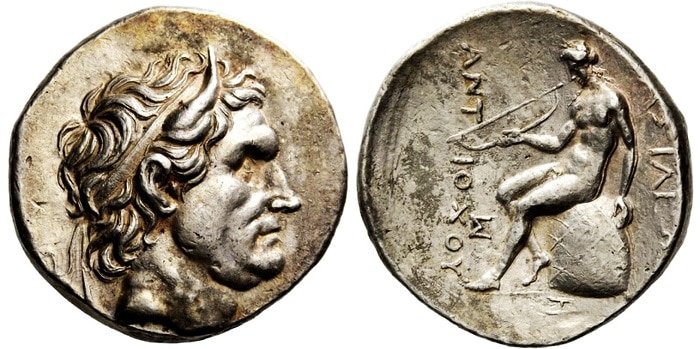More often than not, the fate of the vast Roman Empire rested upon the shoulders of its emperors. Without a good leader at the helm, the entire mechanism of such a powerful realm could quickly collapse. But the reality of leadership meant that emperors could seldom rule in peace as their reigns were often plagued by intrigues and rivalry.
One of the classic examples of the instability that followed a Roman Imperial family is the Severan Dynasty which reigned between 193 and 235 AD, with varied success. During this time, some of the best known Roman emperors contributed to the rise and fall of this mighty ancient civilization. So, what made the Severan Dynasty special?

Septiums Severus, depicted with his wife Julia Domna, and his sons Caracalla and Geta, on a coin minted in 202. (Classical Numismatic Group, Inc. / CC BY-SA 2.5 )
The Severan Dynasty Assumes Power
The Severan Dynasty is named after its founder, Lucius Septimius Severus. Born in Leptis Magna, a city in modern-day Libya, in 145 AD, Lucius Septimius Severus belonged to a wealthy equestrian family. Educated in Rome, he ultimately served as a consul and held various important offices.
In 191 AD, following the assassination of Emperor Commodus, the Praetorian Guard —the elite bodyguard of the emperor—essentially auctioned off the throne to the highest bidder. This happened to be the wealthy senator Didius Julianus, whose rule was short-lived and unpopular. Three generals, Pescennius Niger, Clodius Albinus and Septimius Severus, each with their own armies, rebelled against Julianus and claimed the throne for themselves.
After a brief struggle for the throne, Severus emerged as the victorious contender, defeating his rivals in a series of battles. This led to his ascension as the first emperor of the Severan Dynasty in 193 AD. Lucius Septimius Severus proved to be a capable and ambitious leader who sought to strengthen and expand the Roman Empire.
During his reign, Severus was predominantly focused on expansion and military conflicts. He initiated numerous military campaigns, particularly in the east, resulting in victories over the Parthian Empire and the subsequent annexation of Mesopotamia. Additionally, he led successful campaigns in Africa and Britain, quelling rebellions and reinforcing Roman authority in those regions.
Severus ruled for 18 years until his death in 211 AD. At the time, he was stationed in Britannia, campaigning against the Picts and nearly conquering Caledonia. Alas, he fell ill and died in Eboracum, the Latin name for the ancient city which is now known as York.
Severus was known for his military strength and expansion, as well as his efforts to centralize and stabilize the Roman Empire. Because of this, he was widely considered as a successful and beneficial Emperor, although his success was not destined to last long. He was succeeded by his two sons, Caracalla and Geta, who ruled jointly for a short time before intrigues and conflicts took over.

Caracalla and Geta as depicted in a 1907 painting by Lawrence Alma-Tadema. ( Public domain )
Ambition and Brutality During Caracalla’s Reign
Caracalla, who ruled from 211 to 217 AD, was Severus’ eldest son. At the beginning, he ruled jointly with his brother, Geta, but their relationship quickly soured. Throughout history, instances of two co-Emperors ruling with success on the throne have been rare indeed. So it was that Caracalla had his brother assassinated and continued to rule as the sole emperor. His reign was marked by a number of significant events and developments, both positive and negative.
One of the most significant changes during Caracalla’s reign was the granting of Roman citizenship to all free men in the empire through the Edict of Caracalla. This was a major shift in Roman law and had significant political and social consequences. It expanded the number of people who could participate in Roman political life, but also placed a significant burden on the empire’s resources and administration. The emperor did this simply to gain popularity amongst the people, as he already had a reputation for brutality and violence.
Caracalla also pursued military expansion during his reign, particularly in the east. He campaigned in Armenia, Mesopotamia and Parthia, and is credited with establishing the province of Mesopotamia, which brought the resources of the Tigris and Euphrates rivers under Roman control. What is more, he waged war against the Germanic Alamanni, with moderate success.
Still, Caracalla’s reign was also marked by violence and instability. He is known for his brutal treatment of his political enemies, openly assassinating anyone who he deemed a threat, including his own brother, Geta. Caracalla is remembered for having pursued a number of costly building projects, including the construction of the Baths of Caracalla , which put a significant strain on the empire’s resources.
In addition, Caracalla’s reign saw a rise in inflation and a decline in the value of Roman currency. This was due in part to the costs of his military campaigns and building projects, as well as the expansion of citizenship, all of which burdened the empire’s economy. But despite these challenges, his reign had a lasting impact on Roman society and law. In the end, Caracalla was assassinated by a disaffected soldier, to whom the emperor refused to grant a centurion rank. This brought a sudden end to a reign that was neither good or bad.

The Baths of Caracalla by Virgilio Mattoni de la Fuente, painted in 1881. The building of the Baths of Caracalla put significant strain on the resources of the Roman Empire. ( Public domain )
The Chaos Brought by Elagabalus
Just three days after the death of Caracalla, a new emperor ascended the throne. This was Marcus Opelius Macrinus, a high-ranking official in the imperial court. He used the moment of chaos to his advantage and grabbed the throne for himself, creating an interlude in the reign of the Severan Dynasty.
Macrinus ruled for just over a year, and his reign was marked with several unpopular and bad moves. Most notably, he disregarded his armies, refusing to pay the raises that Caracalla promised. Because of these unpopular moves, Macrinus’ reign was never destined to longevity.
The troops—the instrumental force in elevation of emperors—quickly began flocking towards a bright new imperial candidate by the name of Elagabalus. This young and ambitious man was a close cousin to the late emperor Septimius Severus, making him an ideal candidate for continuing the reign of the Severan Dynasty. After a brief conflict, Macrinus was soon defeated and executed. Elagabalus emerged as the new emperor, restoring the briefly deposed Severan reign.
The reign of Elagabalus, also known as Heliogabalus, was, however, one of the most controversial and tumultuous periods in Roman history. Elagabalus was just 14 years old when he was declared emperor in 218 AD, and his reign was marked by a series of scandals, controversies and plenty of political turmoil.
One of the most notable aspects of his reign was his introduction of the worship of the Syrian sun god, Elagabalus (whose name he bore). He brought with him a black conical stone, which he claimed was the sacred image of the god and built a temple to house it on the Palatine Hill . This was a significant departure from traditional Roman religion, one that was met with resistance from many Romans who saw it as a threat to their traditional beliefs and practices.
Elagabalus also engaged in a number of scandalous and controversial behaviors, including marrying and divorcing multiple women, dressing in women’s clothing and engaging in sexual relationships with both men and women. He was also accused of committing incest with his mother and engaging in other taboo sexual practices. Surrounded by rumors, some of which were outright fantastical, Elagabalus garnered widespread unpopularity, earning the disdain of virtually everyone.
Despite these scandals, Elagabalus was not solely focused on religious and personal affairs. He also pursued military campaigns against the Parthians and attempted to reform the imperial bureaucracy. However, his attempts at reform were often undermined by his lack of experience and his focus on personal interests.

Many regard Elagabalus as the worst Roman emperor in history. In this painting by Lawrence Alma-Taderna, he is depicted lying down in a golden robe watching as his guests are suffocated by rose petals to the glee of the tyrannical emperor. ( Public domain )
The Steady Decline of the Severan Dynasty Could Not Be Prevented
Ultimately, the reign of Elagabalus was marked by constant political turmoil, with several attempts made to overthrow and replace him with other candidates for the throne. Eventually, in 222 AD, the displeasure of the people culminated, and he was brutally assassinated by members of the Praetorian Guard, only to be replaced by his first cousin, Severus Alexander, who also belonged to the Severan Dynasty.
Elagabalus’ headless body was simply tossed into the Tiber River. His reign contributed to the decline and instability of the Roman Empire, as it further eroded the traditional values and practices that had held the empire together for centuries.
Following the assassination of his cousin, Elagabalus, Severus Alexander was declared emperor in 222 AD at the age of 13. Spanning until 235 AD, his reign was characterized by a multitude of challenges and notable achievements, one of the most notable being his emphasis on diplomacy and compromise.
Severus Alexander sought to establish peaceful relations with Rome’s enemies, particularly the Persians, pursuing a policy of negotiation rather than military aggression. He also worked to improve the administration of the empire and to promote the welfare of its citizens, particularly by reducing taxes and improving the infrastructure of the cities.
Nevertheless, despite his efforts at reform and diplomacy, Severus Alexander faced a number of challenges during his reign. In particular, he struggled to maintain the loyalty of the military, and faced several rebellions and assassination attempts. He was also criticized for his reliance on his mother, Julia Mamaea, who was accused of exerting too much influence on him and the imperial administration.
Severus Alexander’s reign also saw significant economic and social changes. He attempted to address the problem of inflation by introducing new coinage and price controls, and worked to improve the condition of the urban poor by implementing new public works projects and providing subsidies for food and other essentials. However, his efforts were not always successful and the empire continued to face economic challenges throughout his reign.
Despite these challenges, Severus Alexander’s reign was marked by a significant cultural flourishing, particularly in the fields of literature and art. He was a patron of the arts and encouraged the production of new works in the areas of poetry and philosophy. His reign also saw the emergence of new literary genres, such as the novel and the biography, and witnessed the work of notable writers such as the historian Cassius Dio and the philosopher Plotinus.
Alas, Severus Alexander’s reign came to an end in 235 AD, when he was assassinated by members of the military who had become alienated and dissatisfied with his leadership. Despite the challenges and controversies of his reign, he is remembered as one of the more moderate and progressive emperors of the late Roman Empire, who sought to promote peace, prosperity and culture within the empire.

The death of Severus Alexander, seen here in a marble bust from circa 230 to 235 AD, brought the downfall of the Severan Dynasty. ( Public domain )
The Severan Dynasty – A Family That Shaped an Empire
The death of Severus Alexander brought an end to the reign of the Severan Dynasty—an imperial family that had plenty of good and bad attributes. It was also an “epochal event”—with his death the Roman Empire entered a serious decline, known as the Crisis of the Third Century . This was a period of almost 50 years of chaos and civil war.
But even so, the Severan Dynasty is remembered for its military strength and the expansion of its territory, as well as its efforts to centralize and stabilize the Roman Empire. Under Severus, the Roman Empire achieved its greatest territorial extent, annexing Mesopotamia as a new province and partially conquering Caledonia, now known as a part of modern-day Scotland. The Severan Dynasty also made efforts to improve the economy and infrastructure of the empire, with the construction of public works such as aqueducts, roads, and public baths.
All of this combined to ensure that the time of the Severan Dynasty was a significant period in Roman history, marked by plenty of ups and downs. While often associated with decline and instability, it also had significant achievements and influences on the cultural and religious landscape of the Roman Empire that would be felt for centuries to come.
Top image: Caracalla as depicted in a 1902 painting by Sir Lawrence Alma-Taderna. Source: Public domain
References
Grant, M. 1996. The Severans: The Changed Roman Empire . Psychology Press.
McHugh, J. S. 2017. Emperor Alexander Severus: Rome’s Age of Insurrection, AD 222–235 . Pen and Sword.
River, C. 2019. The Severan Dynasty: The History and Legacy of the Ancient Roman Empire’s Rulers Before Rome’s Imperial Crisis . Independently Published.
Related posts:
Views: 0
 RSS Feed
RSS Feed

















 July 9th, 2023
July 9th, 2023  Awake Goy
Awake Goy 





 Posted in
Posted in  Tags:
Tags: 
















